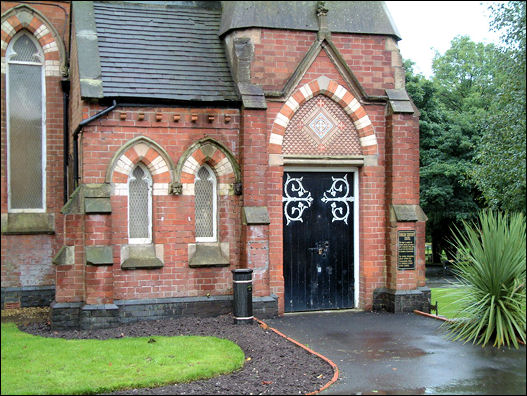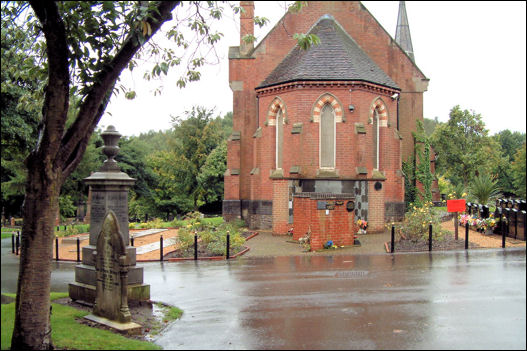|
Burslem Cemetery, Nettlebank, Hanley Road, Burslem
|
The cemetery chapel

The Chapel at
Burslem Cemetery
photo - September 2008 - just before demolition
"Auntie Hamps tramped for over a third of a mile along the asphalted
path winding past the chapel to the graveside"
Arnold Bennett, These Twain (1916)

Minton tiles
over the entrance door
Hartshill and Hanley cemeteries had separate non-conformist
and Church of England chapels that were mirror images of each other.
To save cost there was only one small, simple chapel at Burslem
which was used by all denominations.



in spite of its
simplicity the chapel had some nice features, such as the Minton
tiles, the ornate window surrounds and the ever-vigilant faces.
Edwin Clayhanger at the cemetery

Arnold Bennett's monument to the left of the chapel
Arnold Bennett, in
his book 'These Twain', has Edwin Clayhanger attending a funeral at
the Wesleyan Chapel in Duck Square (actually Swan Square), Burslem
and then an interment at Burslem Cemetery - the following is a
selection of that event.......
|
"Edwin was met by a saying
that 'the last journey must be the longest': which meant
that the cortege must go up St Luke's Square and along the
Market Place past the Town Hall and the Shambles, encountering
the largest number of sightseers, instead of taking the
nearest way along Wedgwood Street. Edwin chose Wedgwood
Street. Edwin scrutinized the coffin, and the
wreaths, and the cards inscribed with mournful ecstatic
affection that nestled amid the flowers, and the faces of the
audience, and his thought was: 'This will soon be over now!
The cortege moved. Rain was threatening, and the streets
were muddy.
At the cemetery it was raining, and the walkers made
a string of glistening umbrellas; only the paid mutes had no
umbrellas....
Vehicles, by some municipal caprice, were forbidden to
enter the cemetery. And in the rain, between the
stone-perpetuated great names of the town's history -the
Boultons, the Lawtons, the Blackshaws, the Beardmores, the
Dunns, the Longsons, the Hulmes, the Suttons, the Greenes,
the Gardiners, the Calverts, the Dawsons, the Brindleys, the
Bainses, and the Woods - the long procession proceeded by
Auntie Hamps tramped for over a third of a mile along the
asphalted path winding past the chapel to the graveside. And
all the way Mr Breeze, between Edwin and Albert, with Bert a
yard to the rear, talked about boils, and Edwin said Yes and
No, and Albert said nothing. And at the graveside the three
ministers removed their flat round hats and put on
skull-caps, while skilfully holding their umbrellas aloft.
And while Mr Flowerdew was reading from a little
book in the midst of the large, encircling bare-headed crowd
with umbrellas, and the gravedigger with absolute precision
accompanied his words with three castings of earth into the
hollow of the grave, Edwin scanned an adjoining tombstone,
which marked the family vault of Isaac Plant, a renowned
citizen. ....
.......And even in that hilly and bleak burial-ground,
with melancholy sepulchral parties and white wind-blown
surplices dotted about the sodden slopes, and the stiff
antipathetic multitude around the pit which held Auntie
Hamps, and the terrible seared, harsh, grey-brown industrial
landscape of the great smoking amphitheatre below, Edwin
felt happy in the sensation of being alive and of having to
contend with circumstance."
Arnold Bennett, These Twain (1916) |
.... some 15 years later Bennett's ashes were to be
interred in the same cemetery.

|
  
next:
Arnold
Bennett
previous:
introduction & consecration |
![]()
![]()
![]()